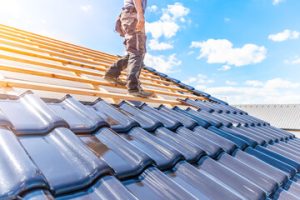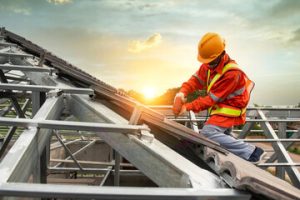Every shelter begins with a roof. It stands as the quiet guardian between human life and the unpredictable sky. Yet, roofing today has evolved far beyond its ancient duty of mere protection. It has become a field of innovation, blending science, sustainability, and design into one seamless form.

Modern roofing carries the pulse of environmental consciousness. It no longer serves only as a barrier but as an energy-generating surface. Solar integration, thermal insulation, and reflective coatings redefine what it means to be protective. The roof now contributes to global energy solutions rather than simply shielding against weather. Contact Cedar Park Roofing for professional help.
The materials themselves have changed with time and technology. Traditional compositions gave way to lightweight composites, recycled membranes, and smart textiles. These materials adapt to heat, repel moisture, and even clean themselves using nanotechnology. Each layer represents an evolution in understanding how surfaces breathe and interact with nature.
Sustainability drives the most dramatic changes in roofing. Experts now design roofs that absorb less heat and reduce carbon footprint. Vegetative or living roofs have turned urban skylines into green ecosystems that restore air quality. The roof has become not just shelter but a living participant in environmental recovery.
Architects now view roofing as a design statement. Slopes, patterns, and materials express character as much as function. A roof can mirror the sky, absorb sunlight, or blend with the landscape. It is both structural necessity and aesthetic language that connects homes to their surroundings.
The technology hidden beneath roofing systems has grown complex. Smart sensors monitor temperature, leaks, and pressure, alerting owners before damage occurs. Automation controls ventilation to maintain interior balance. The modern roof listens, learns, and reacts like an intelligent skin.
Roofing specialists now approach their craft as engineers of climate control. Their work shapes thermal comfort, energy costs, and even indoor air quality. The choice of insulation or color can alter a building’s entire environmental footprint. Each decision becomes a statement about responsibility and foresight.
Storm resistance remains a crucial test of roofing excellence. Wind tunnels and digital modeling simulate hurricane-level forces before materials are approved. The roof must bend without breaking, shield without suffocating, and endure without decay. True strength lies in flexible design, not rigid form.
Water management has become a science within roofing. Drainage systems now redirect rainwater into collection tanks for reuse. Permeable layers prevent pooling and structural stress. The roof, once passive, now becomes a vital part of a building’s water conservation plan.
Temperature extremes continue to challenge innovation. Reflective and radiant barriers reduce heat absorption during scorching days. Insulative membranes trap warmth when cold settles in. This balance creates adaptive roofs that evolve with changing climates rather than resist them.
Acoustic design has also entered the world of roofing. Urban noise can now be softened through sound-absorbing layers that make spaces quieter. The roof no longer echoes chaos from above but instead filters it. It transforms noise into peace without sacrificing strength.
In recent years, the rise of modular roofing systems has revolutionized installation. Pre-fabricated components allow faster construction with less waste. Each piece fits precisely, ensuring durability and visual uniformity. The efficiency reflects a broader architectural movement toward precision and minimal impact.
Safety standards have never been higher. Roofing professionals train in advanced anchoring systems and harness technologies. They navigate heights with precision while ensuring environmental compliance. Their craft is one of risk balanced with artistry.
The artistry of roofing lies in invisibility. The perfect roof goes unnoticed because it performs flawlessly. It absorbs the force of wind, rain, and sunlight without complaint. Its silence is proof of its success.
Climate change, however, has redefined what “success” means. Roofs now need to contribute to mitigation rather than adaptation alone. Energy-producing surfaces and carbon-neutral materials push the industry toward self-sustaining architecture. The roof becomes an active participant in planetary balance.
Biophilic roofing designs embody this change. Moss gardens, pollinator habitats, and micro-farms now exist where shingles once dominated. Rooftops breathe, bloom, and sustain small ecosystems. Life continues above our heads in ways both natural and futuristic.
The cultural meaning of roofs has also evolved. They represent security, but also aspiration—protection combined with purpose. For many, the rooftop has become a social or contemplative space. It connects human beings back to the open sky from which they once sought shelter.
Durability remains the foundation of roofing innovation. Researchers explore molecular coatings that resist corrosion, mold, and UV damage. Longevity translates into reduced environmental strain and long-term value. A durable roof tells the story of endurance over decades.
Recyclability stands at the center of new material development. Old roofing waste once filled landfills without a second life. Now, polymers and composites can be reprocessed into new construction materials. The cycle of use and reuse closes the loop between consumption and conservation.
Technological integration has blurred the line between roofing and renewable energy. Photovoltaic tiles replace separate panels, merging design with function. The surface itself becomes a generator of clean power. Each rooftop transforms into a miniature energy plant.
Artificial intelligence now assists in roof diagnostics. Drones equipped with thermal imaging detect weaknesses invisible to the human eye. Algorithms analyze weather data to predict maintenance needs. Preventive care replaces emergency repair, saving both resources and energy.
Human craftsmanship remains irreplaceable despite technology’s rise. Skilled roofers interpret nuances machines cannot—texture, tension, and weather instinct. Their work is precision wrapped in intuition. Every seam and edge reflects years of practiced perception.
Cultural differences shape roofing traditions across communities. Some prioritize steep slopes for heavy rain, while others design flat terraces for living or farming. These variations tell stories of adaptation and creativity. Roofing becomes a mirror of how societies respond to their climates.
Innovation continues through experimentation with bio-based materials. Fibers from plants, resins from algae, and natural composites enter the scene. These alternatives promise strength without pollution, performance without compromise. Nature once again provides the blueprint for progress.
Maintenance has transformed into a predictive process. Sensors feed performance data to cloud systems that calculate service intervals. Technicians act before deterioration begins. The system’s health is monitored as carefully as a living organism.
The sound of rain on a roof remains timeless. It symbolizes protection and rhythm—the conversation between man and nature. Even as roofing grows more technological, this emotional connection endures. It reminds us that comfort begins with shelter and sound.
Emergency response roofing has gained importance in disaster-prone regions. Rapid-deployment systems can be installed within hours to restore safety. These temporary yet durable solutions prove how adaptability defines modern construction. Roofing has become the first line of recovery.
Energy efficiency continues to guide new designs. Cool roofs reflect sunlight, reducing interior temperatures and lowering power consumption. Such small adjustments ripple into major ecological benefits. The roof becomes an ally in reducing urban heat islands.
The color of roofing now plays an environmental role. Light hues deflect solar energy, while dark ones capture warmth for cold climates. Every tone has a thermal purpose beyond appearance. The palette of roofing paints the world in balance and strategy.
Cultural aesthetics continue to inspire artistic expressions. Designers integrate pattern and geometry into shingle alignment, turning practicality into art. The skyline becomes a gallery of textures and lines. Function and beauty exist without opposition.
Green construction certifications push roofing to new ethical standards. Eco-labels demand proof of recyclability, efficiency, and emissions control. The roof’s composition reflects a building’s moral compass as much as its structural integrity. Responsibility is now measurable in layers.
Technology has also introduced reflective coatings that purify air. These materials break down pollutants when exposed to sunlight. Roofing now participates in cleaning the atmosphere instead of merely withstanding it. The once static surface becomes an active environmental tool.
Noise and temperature control blend with aesthetic versatility. Homeowners and builders can tailor roofing systems to local soundscapes and climates. Every configuration offers unique performance. Customization ensures that no two roofs function exactly alike.
Resilient roofing systems prepare for the future’s uncertainties. Floods, winds, and heatwaves challenge traditional construction, yet inspire innovation. Adaptive membranes and impact-resistant materials promise longer life. The roof learns to evolve just as its builders do.
Training programs for roofing professionals now include digital literacy and environmental ethics. Skills once limited to physical labor now extend into design and analysis. Workers become technicians, strategists, and environmental stewards. The trade matures alongside the technology it commands.
Society’s perception of roofing is shifting toward appreciation. People recognize its invisible contribution to comfort, safety, and sustainability. The structure above us embodies trust—crafted by human hands, strengthened by science. It is the architecture of reassurance.
The future of roofing lies in synergy. Collaboration between engineers, biologists, designers, and data scientists will shape systems that live and think. The boundary between natural and artificial fades with every innovation. The roof of tomorrow will be alive in function and form.
Yet, despite all transformation, one truth remains constant. A roof is still a promise—a shield that endures, breathes, and protects. It bridges centuries of craftsmanship with the dawn of smart design. Under its shelter, humanity continues to dream, evolve, and thrive.

